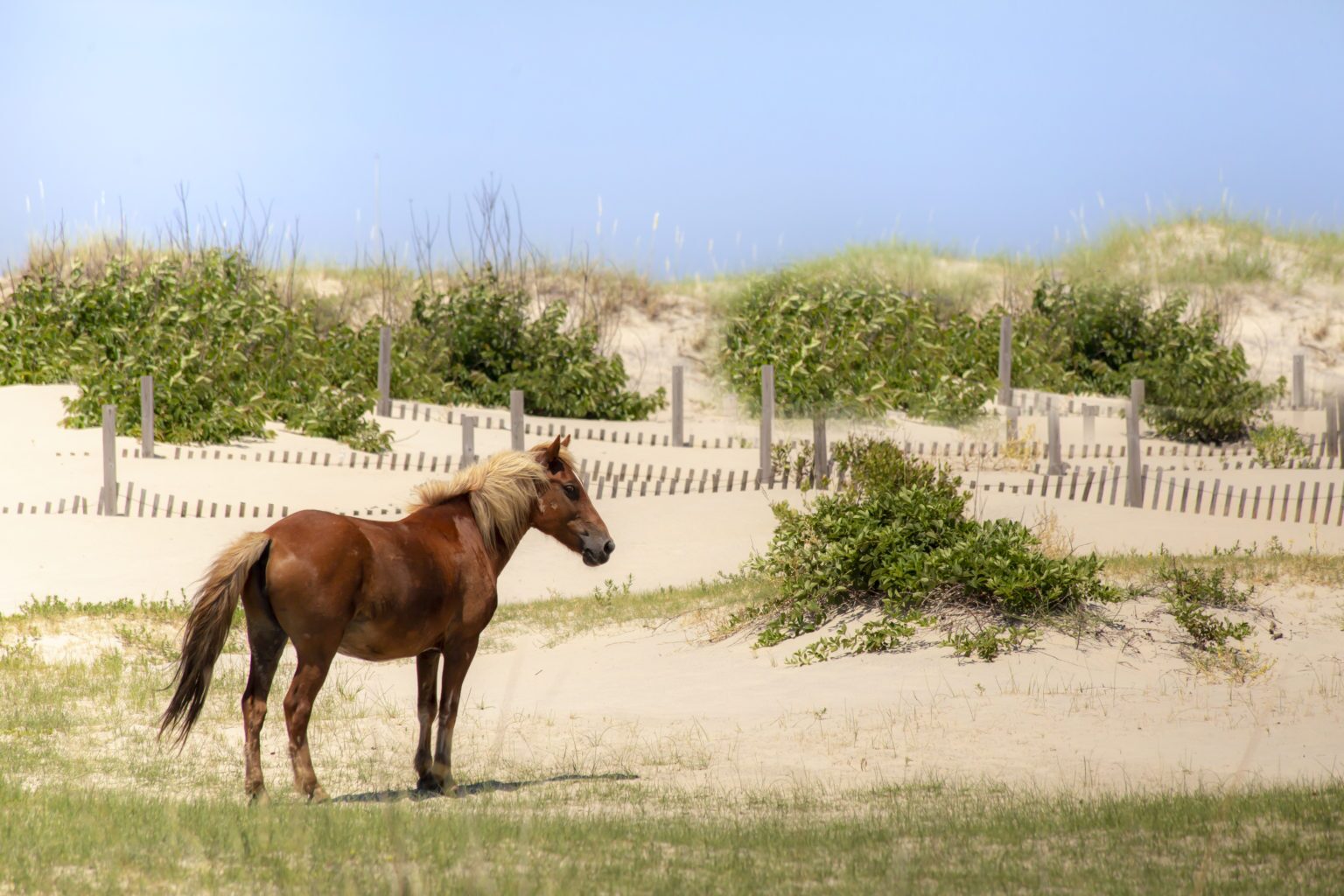Corolla wild horses on the Outer Banks, NC are a major draw for tourists around the USA. These OBX wild horses are incredible to see in their natural habitat along the beaches of Corolla. Standing in silhouette against the horizon or playing in the surf on a hot day, the Colonial Spanish Mustangs that roam the Carova area have sparked the imaginations of thousands of visitors to the Outer Banks.
Many visitors ask what the best time of year to see wild horses on the Outer Banks is. The answer to this question is the summer as in the winter the herd retreats from the beaches of Corolla and into the woods. We are also often asked where the wild horses are on the Outer Banks and as noted, the best place to view these stunning animals is the Corolla, NC area.
Because they are not native to North America, they are considered feral animals by wildlife biologists—but they have been a part of the Outer Banks environment for so long, that referring to them as wild horses is not unreasonable.
While it is incredible to see these wild horses on the beaches of the Outer Banks it is important to do so safely (for both yourself and the horses). There is a “50 foot rule” that locals and visitors are asked to adhere to. Read more about how to safely, respectfully and legally view the wild horses of the Outer Banks on our “The 50’ Rule – Keeping your distance from NC’s Wild Horse” page.
We have observed and learned some things over the years about these incredible horses and have compiled five perhaps not-so-well-known facts about them below.
Outer Banks Wild Horses

No one really knows how they got here
It is, perhaps, romantic to think the Outer Banks wild horses escaped from sinking ships and swam ashore. Romantic, but highly doubtful. The state-of-the-art method for transporting horses in the 16th century had them suspended from slings below deck to protect their legs from the rolling motion of a ship at sea. It’s hard to imagine a sailor taking the time to free a horse as a ship is foundering.
More likely, the wild horses were left behind when the Spanish abandoned failed colonies from Florida to South Carolina. It is also possible the wild horses came ashore with exploration parties and were abandoned when the explorers returned to their ships.
At one time the herd was 5000-6000
According to a 1926 National Geographic article by Melville Charter, the Outer Banks herd of wild horses numbered between 5000-6000 head at that time.
The number may seem high, but it may be accurate. The wild horses were a valuable resource to Outer Banks farmers who allowed them to range freely over their land, rounding them up to be sold to mainland buyers once or twice a year, so horse populations, in general, were protected.
A number of factors came together to create a precipitous decline in the wild horse population.
In the 1930s the state legislature mandated that horses had to be kept in enclosures, and farmers did not have the money during the depression to build horse pens.
Perhaps most devastating was the National Park Service’s decision when Cape Hatteras National Seashore was created that the horses were a nuisance species — they put a bounty on them.

The wild horses were used for coastal patrols
During WWII the US Coast Guard had a robust presence on the Outer Banks and the native wild horses they found were ideal for helping to patrol the shoreline.
Even before the Coast Guard started using the wild horses, their predecessor, the Lifesaving Service, regularly used Banker Horses for patrolling and hauling equipment to rescue sites.
The Shackleford Banks Wild Horses are kissin’ cousins
Genetic testing has confirmed there is a direct genetic link to the Spanish Mustangs of history and the Corolla Wild Horses. However, because of their isolation, the Corolla herd has become differentiated from the mainstream Mustangs of the American plains.
There is speculation, because of their isolation over time, that the Outer Banks wild horses herd is the closest to the original breed of the horse. The closest genetic breed to the Outer Banks wild horses herd is the Shackleford Banks Wild horses—so close that when the Outer Banks wild horses herd wanted to add a stallion to aid genetic diversity, Gus, a young Shackelford stallion was imported.
Gus is somewhat shy and unaggressive, although at last report he had paired up with one or two mares.

The Outer Banks wild horses herd changes location by season
The iconic image of the Corolla Wild Horse is a harem—one stallion and four or five mares—hanging out on a Corolla, NC beach on a hot day. And in the summer, on the beach or bathing in the canals is a likely place to find them.
The herd, however, is not static, and in the winter it almost disappears from sight. The people who seem to know the Corolla Wild Horses best speculate that they head back to the woods and marsh along the sound, probably taking advantage of the trees to protect them from the wind and salt spray of the season.
The herd census is done in the fall because of the fact that the horses are so hard to find in the winter.





